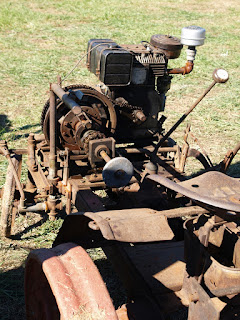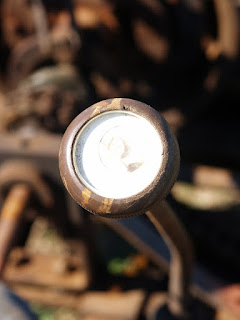This month it’s your turn to supply the information. That’s because in the next few minutes, I'll have told you everything that I know about this piece of machinery.
The Iron Mule
Steam Engines, Antique Tractors and More.
Wednesday, December 1, 2021
Mystery Metal
Monday, November 1, 2021
Page Garden Tractor
A short while back we took a look at a Red E Tractor. In this post we’ll examine one of it’s siblings, cousins or whatever the family connection is between the Red E Tractor Co. and the Page, Dairy and Farm equipment Company.
Friday, October 1, 2021
D-4 Tournapull
Tom Trenka has done a good job of providing visitors to the Richland Creek Fall Festival with some information about his Tournapull, it’s all up there on the big board. Granted, he’s not a graphics professional but it gets the job done. You probably won’t be able to read it on your device so I’ll run down what it says below.
Wednesday, September 1, 2021
Red E Tractor
In 1918 a mechanical engineering student at Marquette University in Milwaukee, Wisconsin presented his design for a two wheel walk behind tractor to his Professor for comment. It’s not reported if the student got an A for his project but Professor Earl Welbourne must have been impressed because by 1920 he was heavily involved with the production of the machine.
Sunday, August 1, 2021
The Jack Rabbitt
If you ask a search engine they will tell you that this engine does not exist. I tried Google, Bing and Duck, Duck, Go and got zero results every time. No matter how I phrased it, I drew a blank.
Thursday, July 1, 2021
Indian Board Track Racer
You won’t see many motorcycles here, mainly because I haven’t come across many that I thought were very interesting. I believe that this one that Walter O’Neal brought to the 2020 Foothills Antique Power Association Show is an exception.
Tuesday, June 1, 2021
Another Huber Maintainer Surfaces
I think it's important to preserve as many examples of antique machinery as possible and private collectors are about the only ones who are doing it. When Troy Rountree sent me some photos of his maintainer and said he was considering selling it, I didn’t hesitate to suggest doing a post on it.
From what I see on Google Stats when I check my Blogger dashboard there is considerable interest out there in antique graders and construction equipment. ( Yes, Google tracks and records everything you do and sells the data they collect to anyone who wants it.) If you are one of those people, here is your chance to add a Huber Maintainer to your collection.
I can’t provide much information about this machine. When you look at these photos, you know pretty much what I do about it. If you would like to find out more, send Troy an email: troy@builderservicesnc.com .
Saturday, May 1, 2021
25 HP Superior Engine
Patrick J. Shouvlin learned his trade working as an apprentice in a railroad maintenance shop in his hometown of Springfield, Ohio. After completing his apprenticeship he worked as a master mechanic for the Chicago, Burlington and Quincy Railroad and eventually wound up on the west coast. When he learned of the oil boom that was underway, he decided to return to Ohio and go into business for himself.
Engines used for pumping in the oil fields were subjected to unusually harsh operating conditions. Many of the brands competing for a share of this market just weren’t up to the challenge. PJ set out to build engines specifically for the oil fields, His engines would be simpler, sturdier and designed for long hours of continuous operation with little maintenance. They would be Superior engines.
In the early years the Superior Gas Engine Co. depended on nearby oil field operators for most of its revenue but in 1894 Shouvlin collaborated with several other firms to form the National Supply Co. that would be headquartered in Pittsburgh, Pa. National Supply would be the distributor for the member companies. As the market expanded Superior’s product line grew to meet new demands. By 1914 they offered horsepower options from 20 to 100 and hopper and tank cooled engines with 2 ½ to 15 hp. ratings as both stationary and portable models.





















































